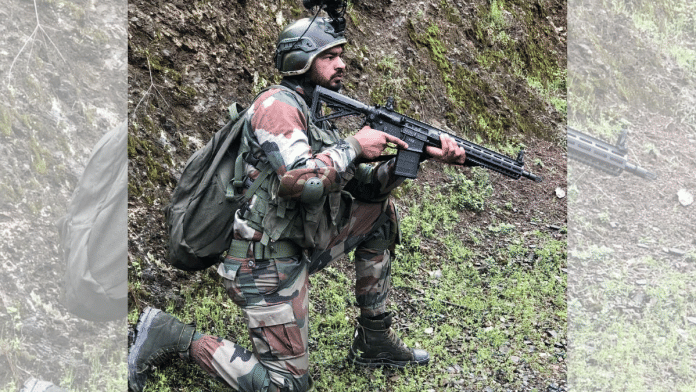The Ministry of Defence’s emergency procurement of an additional batch of 73,000 US-made SIG Sauer 716 assault rifles casts a shadow on indigenous research and development competence. Producing combat rifles isn’t rocket science, and India has world-class capabilities.
Even the ideologically committed and most conservative publication is gobsmacked by the decision. Swarajya, an icon of the intellectual Right, has virtually taken off its gloves in a scathing article that doesn’t spare even the Indian Army. An institution that escapes scrutiny has been severely reprimanded.
The sad reality is that the magazine author isn’t entirely wrong in laying a substantial part of the blame on the Army. India’s small arms policy should’ve been led by the Army to streamline the identification of a weapons family that covers the entire gamut of man-portable assault platforms, whether hand-held or shoulder-fired. It should’ve been Army-led because it is the largest user, with the most experienced manpower in terms of handling and maintenance. From elite Special Forces to the district police constables, the necessary products could’ve been identified based on requirements.
Costly affair of rifles
There are certain essentials when it comes to identifying man-portable weapons systems, and for an institution of the State, a major factor will always have to be the economics of scale. Given the nationwide demand, it isn’t difficult to arrive at an extremely accurate figure, especially considering that the Indian Space Research Organisation (ISRO) has been launching rockets into space for more than 60 years, including indigenously built ones since 1965.
Once the number is finalised, even a rounded-off figure, then the process of identifying the full gamut of operational requirements could be followed. From covert special ops to law enforcement.
Across the entire operational spectrum in India—ranging from district-focused law enforcement to anti-Naxal, counter-terrorism, conventional combat, border patrolling, and elite interventionist special ops—there are certain unavoidable platforms. An efficient assault rifle, and a simple sidearm. Over time, the ideal calibre for sidearms carried by police and military personnel has been zeroed in at 9mm. It’s because of the 9 mm round’s effectiveness, manageable weight, cost efficiency, and ease of logistical maintenance. For both protection and assault, it remains unanimously approved.
This is what makes the topsy-turvy rifle selection process most intriguing—the principles applied to hand-held arms should equally apply to should-fire platforms. Key factors are calibre suitability, cost of purchase, the weight of each round calculated as the total carrying capacity of a soldier (besides his other load requirements), and finally the logistical costs of maintaining the rifles in such volumes, including long-term spares. While almost all police and military pistols across India are now 9mm, rifle types proliferate to a mind-boggling degree, each raising unimaginable maintenance costs.
Also read: India is turning Bay of Bengal into SSBN bastion. China can overreact
The evidence of this multiple-selection and purchase profligacy is most glaring in India’s most heavily armed city, New Delhi. From various state armed police units, Indian Reserve Battalions, Central Armed Police Forces, Delhi Police with its own extravagance, various protection units, and the Union armed forces, each uniform stamps its identity with the variety of weapons it displays. The armoured of each unit can testify to this nightmare, as can those tasked with managing India’s bills, for this recklessness has cost the country unnecessary waste of money. It is, of course, impossible to turn back to when the proliferation began.
However, it’s possible to start rationalising India’s small arms policy. Far too many specious arguments are made to justify multiple platforms being purchased in a piecemeal manner. Simple facts suggest that most operations, from law enforcement to the Jihadi and Naxal anti-terror operations, require a simple-to-use and maintain rifle and a quick-to-use pistol. Both need to fire bullets light enough to carry and cost-effective to be fired extensively in practice and combat modes. Jihadis and Naxals can be neutralised just as easily by a 5.56mm as a 7.62mm, which is lighter and easier to carry.
This logic can quite easily be extended to light machine guns (LMGs), which are a peculiarly military requirement. The same calibre can apply to LMGs, with only highly specialised yardsticks for the extremely limited purchase of sniper rifles, and medium or heavy machine guns. India made a foray into creating such a family tree with its indigenous Indian Small Arms System (INSAS) platforms. However, shoddy engineering, dodgy plastics, and metallurgy ensured that the chorus against the INSAS family reached a crescendo far sooner than anticipated. As a Mark I product, it was a start, but India tends to throw out baby and bathwater together.
India became the first Asian country to fly an indigenously designed combat aircraft more than 60 years ago with the maiden flight of the Hal HF-24 Merut. Within two decades of that landmark event, it was retired in the early 1980s as inefficient engines couldn’t sustain its superior aerodynamics. Instead of addressing the root of the problem, India discarded the entire project and began reinventing the wheel with its Light Combat Aircraft, which still relies on imported engines to fly, even as Indian algorithms have landed space platforms on the dark side of the moon. Rifles are far simpler technology.
Manvendra Singh is a BJP leader, Editor-in-Chief of Defence & Security Alert and Chairman, Soldier Welfare Advisory Committee, Rajasthan. He tweets @ManvendraJasol. Views are personal.






